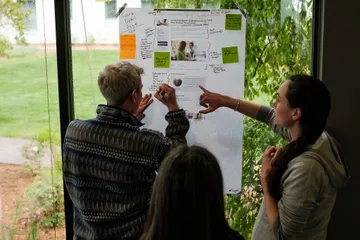The Case for Human-Centered Project Management

Human-Centered Design has long been applied to problem-solving across industries. Here’s how to put it into practice and craft a project ecosystem that delights.
Human-Centered Design (HCD) and its perhaps more famous cousin, Design Thinking, have long been applied to problem-solving across various fields and specializations. HCD teaches us that the most effective way to create something that works well for people is to anticipate, validate, and accommodate the inherently human needs of those who will use it. This approach lends itself to almost any discipline, but is typically applied to the creation of physical and digital products.
Let’s take that a step further and extend HCD to project management itself, and specifically the creation of the “project ecosystems” in which those products come to be.
In contrast to a “system” (a collection of interoperating things), an “ecosystem” is a community of living beings and their environment functioning as a unit. A “project ecosystem” therefore consists of all the people, relationships, tools, processes, and external factors that function toward the project’s objective. In my previous life as a social worker, seeing people in the context of the various micro, mezzo, and macro-level ecosystems in which they operate was known as Person In Environment (PIE) Theory or the Social Ecological Model. This core tenet of social work practice supports the underlying theory behind HCD and reinforces the rationale for its application in the project ecosystem.
Project managers often live by the Triple Constraint Model, which tells us that the three “levers” in a project system are scope, timeline, and budget. As we pull one lever, the other two are predictably impacted, and the entire project can shift in the desired direction. Sometimes we hear about quality or risk as a fourth lever, usually referring to the project’s outcomes: How well did we achieve the target objective and circumvent potential pitfalls? Striving for quality is, of course, essential. However, if we reframe that fourth lever as delight, we can apply it to both the project’s outcomes and the human experience of participating in the project ecosystem.
The idea is simple: build a project ecosystem that effectively supports the real humans working within it, and those humans will be poised to do their best work and deliver a quality product every time. Let’s take a look at the four principles of Human-Centered Design (and a few supporting social work concepts) as they relate to the management of digital project ecosystems.
Acknowledge that everything is a(n eco)system
At the core of the PM role is the facilitation of a team’s success by creating an environment in which team members can do their best work. Yes, we’re responsible for keeping the budget and timeline on track and delivering what we said we would. But to do that, we design, implement, and iterate on the project ecosystem. At Viget, whether we’re building a custom application from scratch or conducting research and design for a brand strategy overhaul, each project represents an independent but interconnected ecosystem. The systemic components include the cadence and format of meetings and progress updates; expectations around internal and client-facing collaboration and conflict resolution; workflows around code review, QA, and release of new software iterations; and all the other processes that we usually don’t notice when they’re going well, but definitely feel it when they’re not.
At Viget, we’ve standardized the basic scaffold of the project ecosystem, but also recognize the need for flexibility. Our team collaboration guidelines set the stage for how we work together company-wide, and in project kickoff meetings we discuss the details of what that should look like on each project. Our project planning template includes space to define which tools we’re using, and the details of how and why. Each lab at Viget is made up of experts who know a thing or two (because they’ve seen a thing or two), and when a project team is formed we all participate in crafting the project ecosystem in which we’ll be working together. PMs attempt to optimize the micro- (individual people and tools) and mezzo-level (project team, client team, and process) elements of the ecosystem, and can do this best when macro-level (agency, client organization, and industry) forces support a human-centered project ecosystem as a matter of policy and philosophy.

Be people-centered
If the project ecosystem is a product in its own right, then naturally it should be designed and constructed in a way that serves its users: the people working on the project! Because we each operate in the context of our role on the project, at Viget, and in our broader world, being a people-centered PM means acknowledging and holding space for each teammate as the whole person they are. Yes, it’s important to make sure that the devs experience minimal friction in code review and QA processes, and designers receive feedback in a clear and actionable form, and nobody’s work is blocked due to missing information or a lack of communication. However, it’s also crucial to recognize and empathize with the extra stuff people bring to work with them, or bring to the project from other work-related realms.
People-centered PMs make the most of the time available in the midst of hectic multi-time-zone calendars and teammates juggling projects, management duties, and life outside of work. They don’t demand to know why a teammate failed to complete a task on time, but instead discuss the factors that contributed to the situation and strategize with their teammate to find a better path for getting the work done (perhaps by adapting the project ecosystem itself). Above all, they practice and promote fundamental communication skills such as listening attentively, seeking to understand, assuming positive intent, and stating thoughts and opinions clearly.

Understand and solve the right problems
Ecosystem-minded and people-centered PMs will notice, celebrate, and leverage the parts of the project ecosystem that are working well. But don’t let a focus on the straightforward, solvable problems facilitate avoidance of the bigger issues. Spending hours organizing documentation might be marginally helpful, but it’s a drop in the bucket if the team is slogging through weekly working sessions that perpetually extend beyond their planned time and result in more questions than actionable decisions. Not only is the project damaged by time spent ineffectively, but people are bound to start feeling ineffectual in their roles and dissatisfied with the work they’re able to produce.
It can be tempting to focus on what’s directly in our line of sight or in our power to influence, but those things might not be the most salient issues hindering progress. Our dev team has written quite a bit about just how much maintenance matters on a development project, for example, and as a PM I can create space for those experts to identify and execute on these types of opportunities to make their project work smoother. (Plus, if it’s good for the dev team, it’s most likely good for the product). While the PM may not be the one automating our CI process or reviewing code, it’s important for us to get comfortable digging down to the root of a problem alongside our teammates so that we can collectively dissect and ultimately solve it. Whether the problem is ultimately related to technical issues, inefficient and un-intuitive processes, interpersonal conflicts, personal challenges, or broader external factors, human-centered PMs will always have an empathetic ear available to understand and collaborate in solving the most pressing problems in the project ecosystem.

Employ small and simple interventions, iteratively
Now that we’re all fired up, let’s overhaul our entire approach to all of our projects! Oh, wait, no…
Besides being jarring for the people involved and therefore difficult to stick with, changing everything all at once makes it impossible to tell which changes are actually effective. It’s the classic lesson from experimental research design: isolate the variable so that it can be observed independently. When applying HCD to the project ecosystem, we want to make small changes, rapidly gather feedback, and repeat until the solution is refined to the team’s liking.
Much like our agile forefathers taught us to do in building software, what we’re striving to do is create a working project ecosystem and iterate on it as we gain momentum. At Viget, we conduct mid-project retrospectives and adjust processes to better suit the team’s current needs. We extrapolate lessons learned in post-project retrospectives to future project challenges. We are highly receptive to feedback and open to adaptation, taking feedback seriously and making genuine efforts to enact meaningful change.
In addition to smaller iterations, simpler solutions are usually the most manageable. We’ve worked with enough large organizations with complex management structures to recognize what an asset it can be to bring in a nimble project team. We’ve seen just how messy user acceptance testing and design reviews can become when our project team ends up in the weeds of multiple layers of conflicting stakeholder priorities. As a way to mitigate this risk from the start, PMs can design straightforward feedback systems that facilitate client teams’ ability to make decisions and provide cohesive feedback which project team members can execute on. When snags arise, we can employ our HCD skills to adjust processes with an eye on the root of the problem and needs of the people involved.

Now What?
On your next project, consider how you will strive for delight. Work to design and manage a project ecosystem that makes space for your team’s (and your) human nature, and maybe even sparks joy. Solve the right problems with people-centered solutions and watch those people flourish. Invest in an environment where people can do their best work, and a high-quality product will ultimately result. If you find yourself closer to the macro level in relation to project ecosystems, consider how you can support human-centered project management in your organization and broader industry. And if you’re ready to work with a human-centered project team, let us know!
